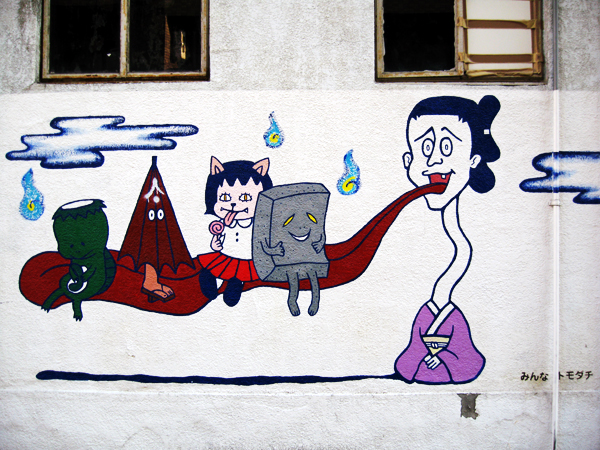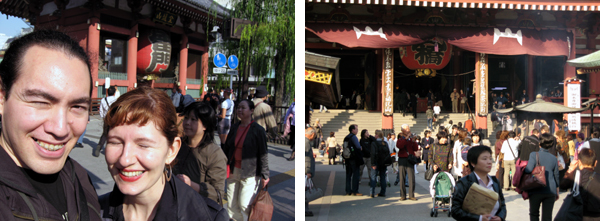11.14.2007 | Fake plastic food

Mural on the side of a building in shitomachi.
Feeling better, but still getting the late start. We mused about getting up early to go to Tsukiji, but that didn't happen and so we punted that plan. Instead we visited the Shitomachi area and the incredibly touristy Senso-ji. We ate ten-don in a crowded spot nearby. We had to share our table on the tatami with another couple, they slim and flush against the rim while we were tangles of entropy with feet and hands poking out beyond the pillows and table edge. We're just too big, even though we're not big at all. They're just so small.
The real reason to visit the area is to see something blue collar and pragmatic, a place where people live and work who do not have the money or time to be concerned with fashion. We wandered narrow, pre-war streets and spied some self-same structures. Over on Kappadashi-dori we wandered the kitchen market in search of plastic food. This, the shinkansen, and electronics, for Andrew. He scored a very convincing beer and, from the half-price bin, a katsu minus the plate. It's possible to pay several hundred dollars for a good plastic model, so the half-price find was a boon. Who needs a plate anyway? The store was packed, mostly with Japanese people, who were getting a good chuckle out of the fake plastic food. The tour book says that Japanese people don't understand why foreign tourists want to buy the stuff, but that didn't seem to be the case. They may wonder, though, why people would be willing to spend so much for it.

Exhibit 1: "It's so sunny!" Exhibit 2: Crowded temple, big lantern.
Patrick Wolf happened to be playing at a club in our neighborhood, so we fumbled our way through locating the venue and buying tickets. 6000 yen a pop, plus a mandatory 500 yen drink ticket at the door—not cheap. But it was fun to check out a show in Tokyo, to see what going to a show here would be like. Some gaijin peppered the audience, but otherwise the crowd was Japanese and very tame. Hardly any fervor, except for some certain intense times when the front rows burst into fistbanging or throwing horns, which didn't quite match the music. No one pogo-danced like the Seattle hipsters do when they get excited. The show started at 7 and finished by 9—early! Patrick put on a good show, consistent with the one I saw in Seattle. It's great that he can really play and really sing, and he can use those skills to improvise and horse around. He gabbed charmingly at the crowd, but much of what he said was lost on most. When he left the stage for a break before the encore, the crowd clapped unenthusiastically. He came out again anyway, but it was funny to wonder about the ritual of encores and how well that translates in Japan.
Afterward we went to a neighborhood Izakaya that was mentioned in the Lonely Planet guide and also our Izakaya guide. It was a small place, warm and convivial. All but the chefs working the knives were inebriated and cheerful. I asked for jizake, junmai daiginjo, and we got Masuizumi from Toyama, generously poured to the rim and overflowing into a saucer. The sake was fresh like water cupped from a spring and it finished cleanly. Andrew said it has a distinct melon quality, I think for it's slight antisepticness. とてもおいしかったです. That kind of order got the attention of the exquisite proprietor, who helped us through their special menu. Slightly drunk, charming, and a bit of a comic, she picked out food for us from the fresh menu. She offered us whale sashimi, but we declined it.... This was some kind of line for Andrew, but not for me. Just eating fish or meat is already dubiously ethical to me, and that is the only line. What is the difference between eating whale or any other animal? But whales are protected. Japan says it hunts whale for research purposes, yet the meat somehow ends up on the menu. And, here it was, in our Shibuya izakaya.
Onward.She selected sea bream sashimi, which came with a variety of mixers that you wrapped with the fish to make an incredibly complex mixture of deliciousness. She also sent boiled yellowtail and daikon on a light broth, which also was delicious. The yellowtail reminded us of salmon.
Our junmai daiginjo order also grabbed the attention of a drunk-off-his-ass man who approached our table, put his big arms around us, and proceeded to slur a series of English words that strung into a story about how he is the president of a sake brewery in Hiroshima prefecture. He said we should visit and gave us his business cards—one card for men, and the other card, with a caricature of him on it, for women. Somehow he couldn't understand that we knew where Hiroshima was, and so he tried to explain about Hiroshima as an "internationally important place." I think he was just too drunk. Our hostess pulled him away with copious expressions of apology that simultaneously preserved his face while letting us know how she felt. Later, another man approached us and explained in quiet English all that the other man had said, which we had gleaned anyway.
We were offered some of the Hiroshima sake and we accepted it even though we could tell that the izakaya staff didn't think highly of it. It seemed the polite thing to do and we were happy to participate that way. We were served a small bottle of it, warmed. We drank it all and became loose and happy ourselves.
We spent about $75 on all that. It was unforgettable.
I'm still surprised at how well the Japanese I learned is working out. Even just a word here and there to help when I can't form full sentences garners relieved looks and hastens the desired outcome unimaginably.